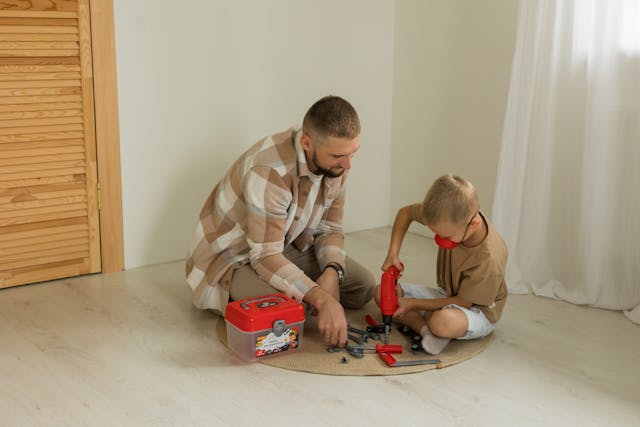How to Read Someone’s Personality in 10 Seconds (Backed by Psychology)

Imagine this: you walk into a room, and within seconds, you can read the vibe of the people around you. You can tell who’s outgoing, who’s reserved, who’s nervous, and who’s confident—all without a word being exchanged. Sounds like a superpower, doesn’t it?
Well, in a way, it is. But it’s a skill that can be developed, and it’s rooted in psychology. We all pick up on social cues and body language, but the real trick is learning how to interpret these cues quickly and accurately. You don’t need a lot of time to form a pretty good idea of who someone is—just 10 seconds is enough.
In this article, we’ll explore how to read someone’s personality in just 10 seconds using psychological principles and nonverbal cues. From body language to facial expressions and voice tone, here’s how to quickly assess the personality of anyone you meet.
1. Pay Attention to Their Posture
Posture is one of the first things you can use to gauge a person’s confidence and comfort level. According to psychology, how someone holds themselves can reveal a lot about their internal state and personality.
Confident People:
- Open posture: Standing tall, shoulders back, and chest open. They take up more space and stand with a wide stance, signaling dominance and self-assurance.
- Direct stance: Facing you squarely with little to no physical barriers between you.
Reserved or Nervous People:
- Closed posture: Slumped shoulders, arms crossed, or legs tightly held together. These individuals may feel insecure or uncomfortable in the situation.
- Leaning back or avoiding eye contact: This could indicate a person who’s either shy or not engaged with their surroundings.
Psychological Insight:
People who project an open posture feel more confident and are often perceived as more approachable. In contrast, closed-off body language can suggest insecurity, defensiveness, or reluctance to engage.
2. Look at Their Eyes and Eye Contact
Eye contact is one of the most powerful ways to assess someone’s emotional state and intentions. Studies show that eye behavior—such as how often someone makes eye contact, how intense it is, and whether they avoid looking at you—reveals a lot about their personality.
Confident People:
- Steady eye contact: They hold eye contact for 4–5 seconds, signaling comfort, confidence, and interest. It’s not overpowering but shows they’re engaged.
- Pupils dilated: If their pupils dilate (even slightly) when talking to you, it suggests attraction or genuine interest.
Shy or Nervous People:
- Avoiding eye contact: Shifting gaze or frequently looking away could indicate discomfort or anxiety.
- Rapid blinking: This can be a sign of nervousness or stress.
Psychological Insight:
Eye contact signals trust and openness. People who make strong eye contact are often perceived as more confident and assertive. In contrast, someone who avoids eye contact may be hiding something, feeling shy, or not fully engaged.
Don’t Miss: How to Rebuild Trust After Betrayal: 10 Proven Steps That Actually Work in 2025
3. Listen to the Tone of Their Voice
The way someone speaks can tell you a lot about their personality. Voice tone, speed, and pitch can give you quick insights into a person’s mood, level of confidence, and even their emotional state.
Confident People:
- Clear, steady tone: They speak with purpose and calmness. Their voice tends to be lower-pitched and more resonant, which signals power and control.
- Measured pace: Speaking at a moderate pace conveys confidence and thoughtfulness. They don’t rush to speak, allowing themselves to be heard.
Nervous or Anxious People:
- High-pitched or shaky voice: A person who speaks in a higher pitch may be anxious, unsure, or feeling vulnerable.
- Fast or erratic speech: If they’re speaking too quickly, they may be nervous or anxious, trying to get their words out before they feel judged.
Psychological Insight:
Your voice mirrors your internal state. A calm, controlled tone indicates emotional regulation and confidence, while a shaky or rushed voice signals anxiety or discomfort.
4. Observe Their Facial Expressions
You’ve heard the saying, “A picture is worth a thousand words.” Well, facial expressions are often the most immediate way to gauge someone’s emotional state. They provide real-time clues about how someone feels without them saying a word.
Confident People:
- Relaxed face: A confident person’s face is generally calm, with few signs of tension. They may smile easily and authentically, which signals warmth and ease.
- Slight, genuine smile: Smiling with your eyes (known as the Duchenne smile) typically signals happiness, openness, and authenticity.
Stressed or Anxious People:
- Tight or tense jaw: A clenched jaw or pursed lips may indicate frustration or irritation.
- Tense forehead or furrowed brow: This often signals anxiety, confusion, or discomfort.
Psychological Insight:
Facial expressions are universally tied to our emotional state. Happiness, fear, anger, surprise, and sadness are all expressed similarly across different cultures, making it a great way to gauge a person’s internal state in seconds.
You May Like: Are You Growing Apart? 7 Signs It’s Happening and What You Need to Do NOW!
5. Notice Their Hand Gestures
Hands and arms are incredibly expressive. The way someone gestures while talking can reveal their personality traits and emotional state in a flash.
Confident People:
- Open, expansive gestures: They use their hands to express ideas and emotions clearly. A confident person will gesture naturally and expand their personal space.
- Hand on the chest or open palms: These gestures suggest sincerity and transparency.
Defensive or Nervous People:
- Crossed arms or hands hidden: These gestures can indicate defensiveness or a lack of comfort in the situation.
- Fidgeting with objects or touching their face: Nervous people often engage in these behaviors to self-soothe.
Psychological Insight:
Hand gestures convey how at ease a person feels. Open gestures suggest comfort and openness, while closed gestures signal discomfort or a desire to create emotional distance.
6. Observe Their Body Movement Speed
How fast or slow a person moves can reveal a lot about their energy levels and emotional state. It’s not just about walking—it’s about how they move in general.
Confident People:
- Purposeful movement: Confident people move at a steady pace with intention, signaling that they feel in control of their environment.
- Relaxed but quick movements: They can move quickly when necessary, without rushing. They understand the balance between urgency and ease.
Nervous or Anxious People:
- Jerky or hesitant movements: Fidgeting, shifting weight from foot to foot, or being unable to sit still are signs of discomfort or uncertainty.
- Slow, deliberate movements: Moving too slowly can be a sign of anxiety or fear, as if they’re trying to avoid drawing attention or being noticed.
Psychological Insight:
The speed of movement reflects the emotional tone. Fast, smooth movements typically indicate confidence and comfort, while slow or hesitant movements point to anxiety or discomfort.
Don’t Miss: How to Move On from a Relationship: Expert Tips to Move Forward
7. Check Their Energy Level
Energy is something we pick up on without even thinking about it. Some people have an aura of energy that draws you in, while others seem to radiate quiet, reserved calmness.
Confident People:
- Balanced energy: They exude positive energy, and their presence feels vibrant but not overwhelming. They know how to engage without dominating the conversation.
- Engaged in the moment: They respond to what’s happening around them, but their energy doesn’t fluctuate wildly.
Tired or Overwhelmed People:
- Low energy: They might seem tired, distracted, or unengaged, not because they don’t want to connect, but because they’re dealing with something internally.
- Avoiding connection: They may pull back from the conversation or activity, indicating they are overwhelmed or preoccupied.
Psychological Insight:
A person’s energy level can be a strong indicator of their emotional state. Someone who is confident and present will naturally have a more consistent and vibrant energy, while someone who is stressed or tired will exhibit more withdrawn or distracted energy.
You May Like: Talking Stage Relationship: Is It Love or Just Wasting Time?
8. Listen for Their Speaking Rhythm
Not just what they say, but how they say it can reveal significant personality traits. The rhythm of someone’s speech can indicate their emotional intelligence, comfort with themselves, and social ease.
Confident People:
- Even, controlled rhythm: They speak at a natural pace and cadence, without rushing or overthinking.
- Natural pauses: They are comfortable with silence and can pause for thought without feeling the need to fill the space.
Nervous or Insecure People:
- Fast, rushed speech: They might rush their words when nervous, which can reflect anxiety or a fear of judgment.
- Too much filler: Using words like “um” or “like” constantly can indicate discomfort with their thoughts or a lack of confidence.
Psychological Insight:
Speech rhythm reflects comfort and confidence. A natural, steady rhythm indicates ease, while fast, jittery speech can signal discomfort or insecurity.
9. Notice How They Respond to Silence
Silence can be one of the most telling moments in any interaction. When there’s a lull in conversation, how does the person react?
Confident People:
- Comfortable silence: They don’t feel the need to fill the silence with meaningless chatter. They can simply exist in the moment.
- Engaged in the pause: They use silence to reflect or consider their thoughts.
Nervous People:
- Uncomfortable silence: They often feel the need to fill the space quickly, either with jokes or excessive talking.
- Fidgeting: Their discomfort with silence might show in their body language—playing with their phone, tapping their feet, or looking around.
Psychological Insight:
The ability to sit in silence comfortably often indicates a level of emotional maturity and confidence. Those who feel uncomfortable may still be working on self-acceptance or social confidence.
Don’t Miss: God-Centered Relationship: The Secret to True Love
Conclusion
Being able to read someone’s personality in just 10 seconds isn’t about making snap judgments or labeling people. It’s about understanding the subtle cues that tell you how someone is feeling, what they value, and how they connect with others. By paying attention to body language, facial expressions, speech patterns, and energy levels, you can quickly get a sense of who someone is—and learn how to interact with them in a way that fosters connection and mutual respect.
The more you practice these techniques, the better you’ll become at reading people—and the more empathetic and insightful you’ll be in your interactions with others.
So, next time you walk into a room or meet someone new, remember: the most important things are often said without words.
FAQs
- How accurate are these techniques?
While no method is foolproof, these techniques provide valuable insight into someone’s personality by analyzing nonverbal cues, which are often more telling than words. - Can these techniques help in professional settings?
Absolutely! These strategies can be particularly useful in professional settings, where understanding someone’s mood, level of engagement, or confidence can help you tailor your approach. - Is it ethical to read people this way?
Yes, as long as you use these techniques for understanding and empathy, not manipulation. It’s important to respect people’s privacy and not use your observations to exploit them. - Can these techniques be learned or are they innate?
These skills can definitely be learned. By practicing active observation and reflecting on your interactions, you can sharpen your ability to read people’s nonverbal cues over time.






